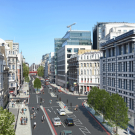
The North-South cycle superhighway is a step closer
Transport for London is asking for your opinion on whether a bicycle ‘superhighway’ that is separated from traffic is something that you’d like, or would you prefer to continue to risk your life.
03 Sep 2014
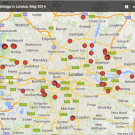
Could red kites be London's next big nature success story?
Red Kites are slowly coming back to London.
The map above shows places in the M25 where the bird was spotted in during May 2014, as reported on the London Bird Club site.
Here’s a zoomable version.
For a bird which was down to 100 UK pairs tucked away in west Wales in the 1980s, it’s a pretty amazing comeback. The bird is now ubiquitous along the M40 and M4 motorways west of the city. But how much room for it is there inside the M25?

What a red kite looks like – the big giveaway is the fanned tail
This will be an interesting test of whether modern London is able to make a home for different wildlife.
Peregrine falcons have already returned in numbers to the centre of London – the can be seen on the towers of Westminster and the Tate Modern. Urban foxes have forced their way in, without human consent.
Could kites, which used to scavange rubbish from the streets of medieval London, join them in the future?
One to watch.
01 Sep 2014

Don't touch that dial: what's wrong with London Live
Welcome to London Live. Like the England team – it’s not doing very well at the moment. Launched in March as part of what the government hopes will be a chain of local TV stations, it was seen as the most lucrative television franchise since Channel 5 arrived in 1997. What went wrong?
15 Aug 2014
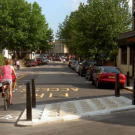
Doing Feminism: Chatting About the Unspeakable With Laurie Penny
On vile internet comments, the pros of perversion, and the bullyboys of the British press.
At 27, Laurie Penny spent a massive amount of time thinking and writing about the reasons hatred towards people who don’t conform is tolerated in the UK. Her articles appear in the New Statesman, Guardian, Independent, and Vice; her blog Penny Red was short-listed for the Orwell Prize and she tweets to over 93,000 followers. In conversation, she’s a charismatic person with a great sense of humour and a wealth of knowledge about the complexities gender, class and race in modern Britain.
18 Jul 2014
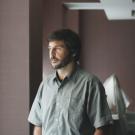
One Minute With Diego Quemada-Diez - Director of The Golden Dream
The Golden Dream is the debut feature from Diego Quemada-Diez, a documentary maker and former cinematographer for Ken Loach. A story of three teen immigrants on a quest from South America to the US, it won the Un Certain Talent Award at Cannes.
What made you become a filmmaker?
I always wanted to be a poet, and I wrote poetry and made short films and I tried to put some poetry into that. José Val del Omar from Granada is an influence—he talks about the meta-mystic of the cinema in a manifesto from the 60’s that I like very much. He says that one should only manipulate the audience if there is a great poetic intention. Forough Farrokhzad is another who made a film about a leper colony called House of Black, it’s pretty intense. I like a lot of Persian, Spanish and South American poets. I think a film should have a poetic layer, a narrative layer and a political layer, so you think why are you making a film, what are you wanting to say. I see filmmaking as a responsibility in a way, like if we trivialise, for example, the killing of somebody—nothing against Tarantino, but when I saw his last film I found myself laughing after you kill 400 people. So dramatising the killing of a human being makes more sense to me because trivialising just helps the military industrial complex and the propaganda of violence.
What was the film’s genesis?
Over 10 years ago, I was inspired by reading about people who immigrate, and I took a plane and ended up in Mazatlan in Cineloa and started making a documentary. One night I met a taxi driver who I made friends with and eventually ending up living with his family. They lived by the railroad tracks, and every day a train would arrive with hundreds of immigrants and I started talking with them, hearing their stories, testimonies and dramas, with the intention of telling their stories. I struggled a lot between wanting to make a film or a documentary and making a living, as a camera operator. Slowly I got clearer about how to solve that dilemma, of how to take from reality the truth of the screenplay. It’s a very difficult method this doc-fiction thing.
Is it fair to say the characters internalise what they’re hoping to escape from?
I took a lot of testimonies from migrants and I found that behind the migration problem there is a post-colonial issue, of two cultures that are clashing, trying to control the other, of a fight for territory. So to articulate that, I found that I could clash an Indian and a mixed-raced character who believed in the western ideal. I thought what if the story becomes the opposition of these two ways of looking at the world, which are totally different from each other, and the westerner transforms his personality and the way he looks at things. I was interested in looking at a sense of brotherhood beyond racism and nationalities. Because they are all artificial creations, it’s not a utopian or idealistic thing to say this, we are all one planet that’s the truth, everything else is a creation we have made to separate ourselves from others. I travel a lot and everywhere I go I encounter this: Korea, China, Japan, Russia.
Ken always told me, “Ok you may have an idea, but the issue is how to articulate it, that’s the most difficult thing,” and I was lucky because I found this idea of the clash, so I thought, “Why don’t I make it about cowboys and indians?” That’s also behind the clash, and enables the story to become a kids film and an adventure film and gives it more layers.
You used amateur actors?
I think the idea of working with non-actors is mostly because I find them fascinating, and in some of the documentaries I made, I found that the truth from a real person is so powerful, it’s nothing that can you find from an actor. I mean an actor has incredible talent, but for this particular film I wanted to give voice to real people, and I had been inspired by this film Rodrigo D , a 1990 film by Víctor Gaviria with non-actors. We saw over 6,000 kids in these communities and at times it was very dangerous, but I thought it was very important. And in the writing process the character becomes a mixture of what you wrote, from real testimonies and your imagination and details you pick up from different places, and then you find the actor and he or she brings so much, though not everything. You take a combination of reality from fiction and vice versa, and you blend them and you hope it’s going to combine properly.
The Golden Dream is beautifully constructed. How did you balance both dialogue and visuals?
Well, film is mostly a visual medium. I always try to watch silent movies and Aki Kaurismaki, he uses very little dialogue, I really hate when a film uses too much dialogue and is overly literal. Trying to create subtext is the most difficult and important thing, as in how you convey an idea without actually hitting the audience with it. I wanted to make a poetic film, so I had to think, what are the tools of poetry in film: visual metaphors, rhymes, elements and images repeating in differing ways. Haneke’s The 7th Continent and also the film Happy Together come to mind, getting you in an abstract mode where you’re trying to understand more conceptual ideas instead of knowing exactly everything. Then I had oppositions: human and machine; birds and cages; cowboys and Indians. I was always thinking about this, trying to work from visual opposites, that you can somehow find and integrate and play with. At one point we found a horse with a cowboy and we said let’s get him in.
Ken taught me that the director is responsible for telling the story visually, for putting the camera and the lens where he thinks. So obviously you collaborate with the cinematographer but one needs to be very clear of how to tell the story visually. I was basically shooting the entire scene with different lenses, but with a sense of becoming a witness of a real event, not really making a movie. You try to film most of the film in continuity, and the actors don’t know the script because you give it to them as you go, start on page 1 and end on the last page, and the actors have a real experience and you really don’t have to do much, you have to focus and the most difficult part is the casting. You put them in situations that feel real, you try to hide the film crew as much as possible, so they forget there is a camera is there, when you’re work-shopping you teach them to lock their eyes on the other actor(s) and at some point everything else becomes invisible and they don’t even care that it’s there. During the film they discover the story as it moves and they discover the reactions within themselves. You focus on creating the context, that provokes their reaction and don’t try to control how they do it, because you want them to be themselves. You rewrite as you go because you want them to be how they would speak to their own people. And all you do is film it as if you were an observer of the event.
The Golden Dream is currently on release in London.
Image of Diego Quemada-Diez Copyright Gavin Mecaniques.
10 Jul 2014
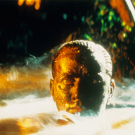
Lost in Transmutation: Literature and film
University classes and glass-eyed professors have long pondered the significance and meaning of the word ‘literature’. The most forthcoming definition is that offered, as always, by the Oxford English Dictionary: “Written works, especially those considered of superior or lasting artistic merit.” But what can this definition reveal to us about film, and how much the form of literature has changed, especially when looking at the inception of the auteur’s contribution? Could a film be termed literature? Perhaps but perhaps not.
24 Jun 2014
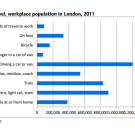
It seems remarkable how many Londoners still drive to work
I’ve lived in London for 5 years and always travelled to work by tube. The vast majority of people I know get to work by tube, bus, or bicycle. Surely that makes me typical?
Nope.
The chart above, from the latest analysis of the 2011 census data by the GLA (pdf), shows how persistent the car remains as a commuting choice.
When you add up bus, tube and trains, you can see that public transport overall carries more passengers than cars. But the 1.2m people who drive to work should stand as a challenge to anyone who doesn’t drive and assumes their experiences of public transport are typical of the majority of Londoners.
And if you believe that having large numbers of people driving to work carries with it a lot of negative consequences for the city, then it should also stand as an illustration of how far away we remain from a vision of London as a city which is not defined in part by the car. Because while this number remains high, the pressure on politicians to deliver for drivers in the form of new roads and driver-friendly policies will remain.
Digging a little deeper, it’s unsurprising that most car trips are made to workplaces in Outer London, where traffic is (generally) lighter and public transport generally less accessible.
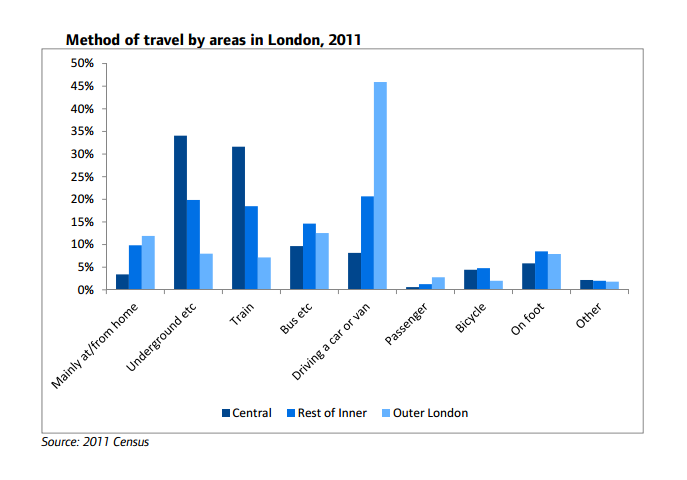
Even so, that 20% of people drive to work in Hackney, Hammersmith & Fulham, Haringey, Islington, Lambeth, Lewisham, Newham, Southwark, Wandsworth (i.e. “Rest of Inner), more than get a bus, seems fairly remarkable.
Perhaps the most important question is how these choices are changing, or likely to change, over time.
Here are the percentage shares compared between the 2001 census and the 2011 census.
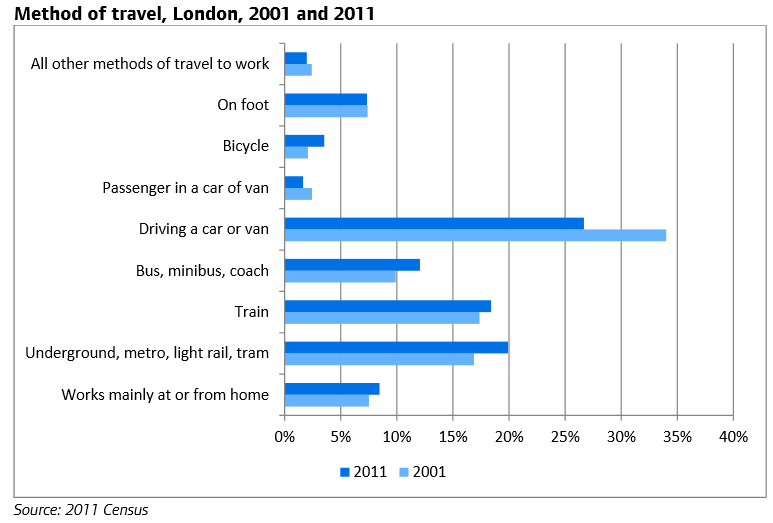
So over time, public transport is gaining and cars are losing. It feels surprising that cycling and working from home have not yet eaten further into the car’s share. If those two shares increase over the next decade and car use declines, would anyone argue that the city will be better off?
24 Jun 2014
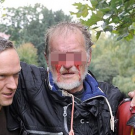
Boris Johnson used to oppose the use of water cannon. What's changed?
London’s Police and Crime Commissioner Boris Johnson refused to comment today following reports that the Met have requested water cannon to use against protesters.
13 May 2014
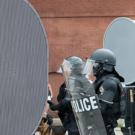
Tories urge Boris to allow police to use 'sound weapons'
Boris Johnson was today urged to allow the police to use sound weapons capable of emitting “harmful, pain-inducing sounds,” against Londoners.
05 Mar 2014
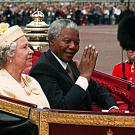
What does Boris Johnson really think of Nelson Mandela?
Boris Johnson has today been heaping praise on Nelson Mandela, who died yesterday.
He told the BBC that the “idea of a latter-day saint is much abused” but insisted that Mandela should indeed be canonised adding that “a great heart has been stilled”.
According to the Beeb:
“When asked about the Conservative Party’s attitudes to Mr Mandela and the ANC in the past, he said he disagreed with it but was “not politically operational” then, adding: “I never in my life deviated from the position of fervent, fervent admiration for Nelson Mandela.”
So is this really true? Has Boris always been a fervent admirer of Mandela? What are Johnson’s real views on the great man?
Well in 1997, Johnson interviewed the former president of apartheid-era South Africa FW de Klerk for the Daily Telegraph. Here’s how he began the article.
“As ye sow, so shall ye reap. Once the Afrikaner discriminated against the black man on the grounds of his colour. Now the boot is on the other foot…”
Later in the interview he added:
“Mandela never accepted the Swiss-style constitution [de Klerk] proposed; and last year, fed up with being marginalised, de Klerk quit the government. He must have known that this would happen, that the majority tyranny of apartheid would be followed by the majority tyranny of black rule.”
In both excerpts the meaning appears clear. The white tyranny of apartheid was replaced with the black tyranny of Mandela.
But did he really believe that or was he just exaggerating for the benefit of his Telegraph readership? It’s not entirely clear.
In another Telegraph interview with South African politician Buthelezi, Johnson refers to Mandela as “the sainted one”.
“The trouble, says Chief Buthelezi, is the way that the sainted one is leading the country: not just the left-wing ideology that has led to a sharp fall in the Rand, a 73 per cent rise in the professional exodus, and which the magazine Business Day says has set South Africa ‘firmly on the road to banana republic poverty’. There is a more sinister resemblance, both to the old Soviet Union and the old South Africa. ‘There is a tendency to develop towards some kind of autocracy,’ he says.”
So was Johnson simply quoting Buthelezi’s views about Mandela’s “sinister” rule, or did he have some sympathy with them? Again it isn’t clear, even from reading the whole piece.
Mandela continues to pop up in Boris’s later writing, most recently in a Telegraph column from 2010.
In this piece Boris mocks celebrities including Naomi Campbell and Imran Khan for accepting an invitation to dinner with Mandela in 1997, despite the fact that “blood soaked warlord” Charles Taylor was also invited.
“Why did they risk that most precious thing, their reputations?” he asks.
“The answer, of course, is that the man at the centre of the group portrait, and their host, was Mr Nelson Mandela, and Mr Mandela is by common consent just about the best, kindest and most gracious man on the planet. It is the goal of every celebrity to have his or her photo taken with Mr Mandela. He beats Obama. He beats the Queen. He knocks the Pope into a cocked hat.”
The mocking tone continues.
“With his radiant smile and his transfiguring presence, he washes away the sins of all those who come near him. It didn’t matter to the slebs that they were in the presence of an allegedly limb-chopping warlord. They were literally in the presence of a saint – or the closest the modern world has come to reproducing this ancient concept. They left reason behind and gravitated towards holiness, the sense of spiritual goodness our species still craves.”
So does Boris think Mandela was a saint for whom he always had “fervent admiration”, or does he think the celebrities had “left reason behind” by assuming that he was.
As always with Boris’s writing, it’s not entirely clear what his real opinions are.
But at the very least, his views of Mandela appear are far more nuanced than his glowing on-camera tributes today suggested.
06 Dec 2013
Snipe Highlights
Some popular articles from past years
- Margaret Thatcher statue rejected by public
- Could red kites be London's next big nature success story?
- Diary of the shy Londoner
- Only 16 commuters touch in to Emirates Air Line, figures reveal
- Nice map of London's fruit trees shows you where to pick free food
- Hope and despair in Woolwich town centre
- The five best places in London to have an epiphany
- The five spookiest abandoned London hospitals
- Silencing the Brick Lane curry touts could be fatal for the city's self-esteem
- London has chosen its mayor, but why can’t it choose its own media?
© 2009-2025 Snipe London.
